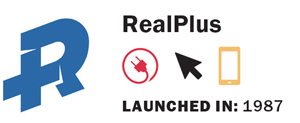
From the March issue: Back-end listings systems for residential firms has long been the domain of two firms: RealPlus and On-Line Residential. But with a slew of new venture-backed competitors such as Perchwell and Nestio breaking onto the scene, the landscape is shifting.
Amid the changing market, The Real Deal decided to take a quick look at RealPlus: Founded in 1987, it was the first company to enter New York’s residential listings game at a time when brokers shared listings via fax or snail mail.
Click here to read the full story: Piping in listings, pumping out cash
Using IBM software, RealPlus began to streamline that process by building listings databases for firms. Then once a day, companies would fax their updated listings to a distribution list made up of other firms.
The service was valuable enough that in 2001, Terra Holdings — parent company to Brown Harris Steven and Halstead Property — bought a 50 percent stake in the company.
In 2002, RealPlus overhauled its business when it launched a shared electronic listing exchange dubbed R.O.L.E.X. to pipe listings between REBNY’s member firms. (R.O.L.E.X. was free, but firms paid for interfaces like RealPlus and OLR to access those listings.)
Now, if a broker at one firm entered a listing into the system, agents at other firms would be able to quickly access it and start showing it to buyers.
But in 2013, REBNY tapped Katonah, New York-based Stratus Data Systems to launch the RLS — replacing R.O.L.E.X. with a newer model.
The changeover was rocky.
Five years later, R.O.L.E.X. still exists, but it’s not partnered with REBNY so it’s only used by RealPlus clients, who are charged roughly $100 to $150 per month for each of their agents, said Eric Gordon, founder of RealPlus. And, it sends its clients’ listings to the RLS, which then feeds those listings industrywide.
But as the environment has grown more competitive in the last year, Gordon has hired more engineers and designers, doubling his staff to around 17. He’s also updated his offerings with mobile apps and other tools.
“We’re forced to do what we have to so we can compete,” he said.
Before last month, its four largest clients were BHS, Halstead, Stribling & Associates and Sotheby’s. But Stribling and Sotheby’s have since jumped to Perchwell, while BHS stopped using RealPlus and instead had Gordon build it a proprietary system called Resource. (Citi Habitats, which once used RealPlus to help manage rental listings, moved that job in-house last year.)
“There are changes that are coming, for sure,” said Gordon. “We have to come up with other ways of keeping relevant.”
RealPlus has, for example, added features to its system to ensure that the RLS (and aggregators) have real-time updates to listings.
“It used to be OK for a listing to be entered at 1 p.m. and show up on syndication sites at 5 p.m.,” said Gordon. “Not anymore.”